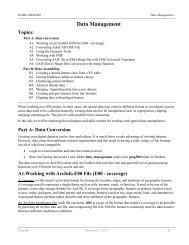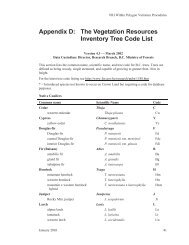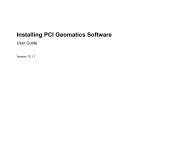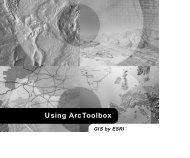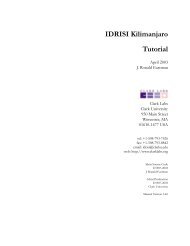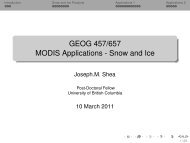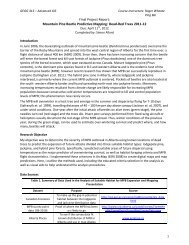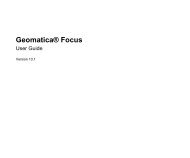Understanding Map Projections
Understanding Map Projections
Understanding Map Projections
You also want an ePaper? Increase the reach of your titles
YUMPU automatically turns print PDFs into web optimized ePapers that Google loves.
Glossary<br />
angular units<br />
The unit of measurement on a sphere or a spheroid,<br />
usually in degrees. <strong>Map</strong> projection parameters such as the<br />
central meridian and standard parallel are defined in<br />
angular units.<br />
aspect<br />
The conceptual center of a projection system. See also<br />
equatorial, oblique, and polar aspect.<br />
azimuth<br />
An angle measured from north. Used to define an oblique<br />
aspect of a cylindrical projection or the angle of a<br />
geodesic between two points.<br />
azimuthal projection<br />
A form of projection where the earth is projected onto a<br />
conceptual tangent or secant plane. See planar projection.<br />
central meridian<br />
The line of longitude that defines the center and often the<br />
x origin of a projected coordinate system.<br />
circle<br />
A geometric shape for which the distance from the center<br />
to any point on the edge is equal.<br />
conformal projection<br />
A projection on which all angles at each point are<br />
preserved. Also called an orthomorphic projection (Snyder<br />
and Voxland, 1989).<br />
conic projection<br />
A projection resulting from the conceptual projection of<br />
the earth onto a tangent or secant cone. The cone is then<br />
cut along a line extending between the apex and base of<br />
the cone and laid flat.<br />
cylindrical projection<br />
A projection resulting from the conceptual projection of<br />
the earth onto a tangent or secant cylinder, which is then<br />
cut from base to base and laid flat (Snyder and Voxland,<br />
1989).<br />
datum<br />
1. A reference frame defined by a spheroid and the<br />
spheroid’s position relative to the center of the earth.<br />
2. A set of control points and a spheroid that define a<br />
reference surface.<br />
datum transformation<br />
See geographic transformation.<br />
eccentricity<br />
A measurement of how much an ellipse deviates from a<br />
true circle. Measured as the square root of the quantity<br />
1.0 minus the square of the ratio of the semiminor axis to<br />
the semimajor axis. The square of the eccentricity, ‘e 2 ’, is<br />
commonly used with the semimajor axis, ‘a’, to define a<br />
spheroid in map projection equations.<br />
ellipse<br />
A geometric shape equivalent to a circle that is viewed<br />
obliquely; a flattened circle.<br />
ellipsoid<br />
When used to represent the earth, the three-dimensional<br />
shape obtained by rotating an ellipse about its minor axis.<br />
This is an oblate ellipsoid of revolution, also called a<br />
spheroid.<br />
ellipticity<br />
The degree to which an ellipse deviates from a true circle.<br />
The degree of flattening of an ellipse, measured as 1.0<br />
minus the ratio of the semiminor axis to the semimajor<br />
axis. See also flattening.<br />
equal-area projection<br />
A projection on which the areas of all regions are shown<br />
in the same proportion to their true areas. Shapes may be<br />
greatly distorted (Snyder and Voxland, 1989). Also known<br />
as an equivalent projection.<br />
101




